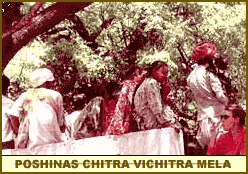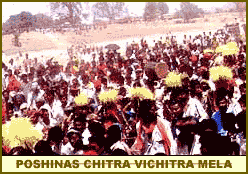| POSHINA'S
CHITRA VICHITRA MELA |
|
| Celebrated In
:
Sabarkantha Distt., Gujarat. |
|
| Centre of
Activity :
Poshina (Village Gunbhakhari) |
|
| Unique Feature
:
One of the Largest Tribal Fairs |
|
| Attended By :
About 60,000-70,000 People |
|
|
|
| Two weeks after Holi in the month
of March/April, the Chitra Vichitra Fair is held at the confluence of three
rivers near the village of Poshina. The fair is attended by tribals in great
numbers, sometimes exceeding 60,000. The site is believed to date from the time
of the Mahabharata, when Chitraveer and Vichitraveer are said to have repented
at the Shiva temple, around which the fair is centred. |
|
| This fair, one of the largest,
purely 'Adivasi' (tribal) fairs is attended by around 60,000 to 70,000 tribal
people. It takes place every year in the village of Gunbhakhari in Sabarkantha
district, very near the borders of Rajasthan. It is held a fortnight after
Holi, the festival of colours. |
|
| THE BEAUTIFUL VENUE: |
| The site of the fair is attractive as the
temple overlooks the rivers Sabarmati, Akul and Vyakul. The name of the fair is
derived from Chitravirya and Vichitraviraya, the sons of King Shantanu, who are
believed to have lived here and been cured of diseases, which afflicted them. |
 |
|
|
| THE COLOURFUL
VISITORS: |
| The Garasia tribals, known for
their colourful attires and chunky jewellery, the Bhils for their archery
skills and ancient culture, and the Rabaris who are primarily pastoral and
sport heavy ornaments are the main tribes at the fair. |
|
 |
The fair attracts large numbers of Bhils
(tribals) who come from all the surrounding districts using every imaginable
form of transport. The Garasis and Bhil tribals dress in their customary
colourful costumes. The costume of the men generally consists of a blue shirt,
dhoti and a red or saffron turban. |
|
|
| Women don 'ghaghras' (embroidered
skirts), which have a circumference of as much as 20 yards, and are covered
from head to foot with ornate and heavy silver jewellery. They use liquid
'kumkum' (vermilion) to colour their cheeks and lips a brilliant red, while
their eyes are outlined with 'kajal' (kohl). |
|
| MAKE YOUR PRESENCE
FELT: |
| Every group that comes to the fair carries its
own drum making the atmosphere come alive with the incessant beat of numerous
drums. The fair also acts as a venue for betrothals, as tribal youth use this
opportunity to find their future spouses. |

|
|
|
| THE MAIN RITUALS: |
| The fair begins with mourning at
the 'triveni sangam' (confluence) at night, which rapidly gives way to
rejoicing, dancing and singing, with stalls selling food and produce. Tribals
from various districts of Gujarat and neighbouring Rajasthan attend the fair,
which is a good time for relatives to meet, or to find a suitable bride -
eloping is not uncommon, though. |
|
| MEANS OF MERRIMENT: |
| The dancing and drumming continue
for hours until everyone is exhausted. Over a hundred stalls hold food and
drink, and sweets of various kinds. Silver ornaments can be bought and
household articles as well. Here, as in other fairs, there is a giant wheel,
and a merry-go-round, which never cease to spin. |
|
|
|
|
|